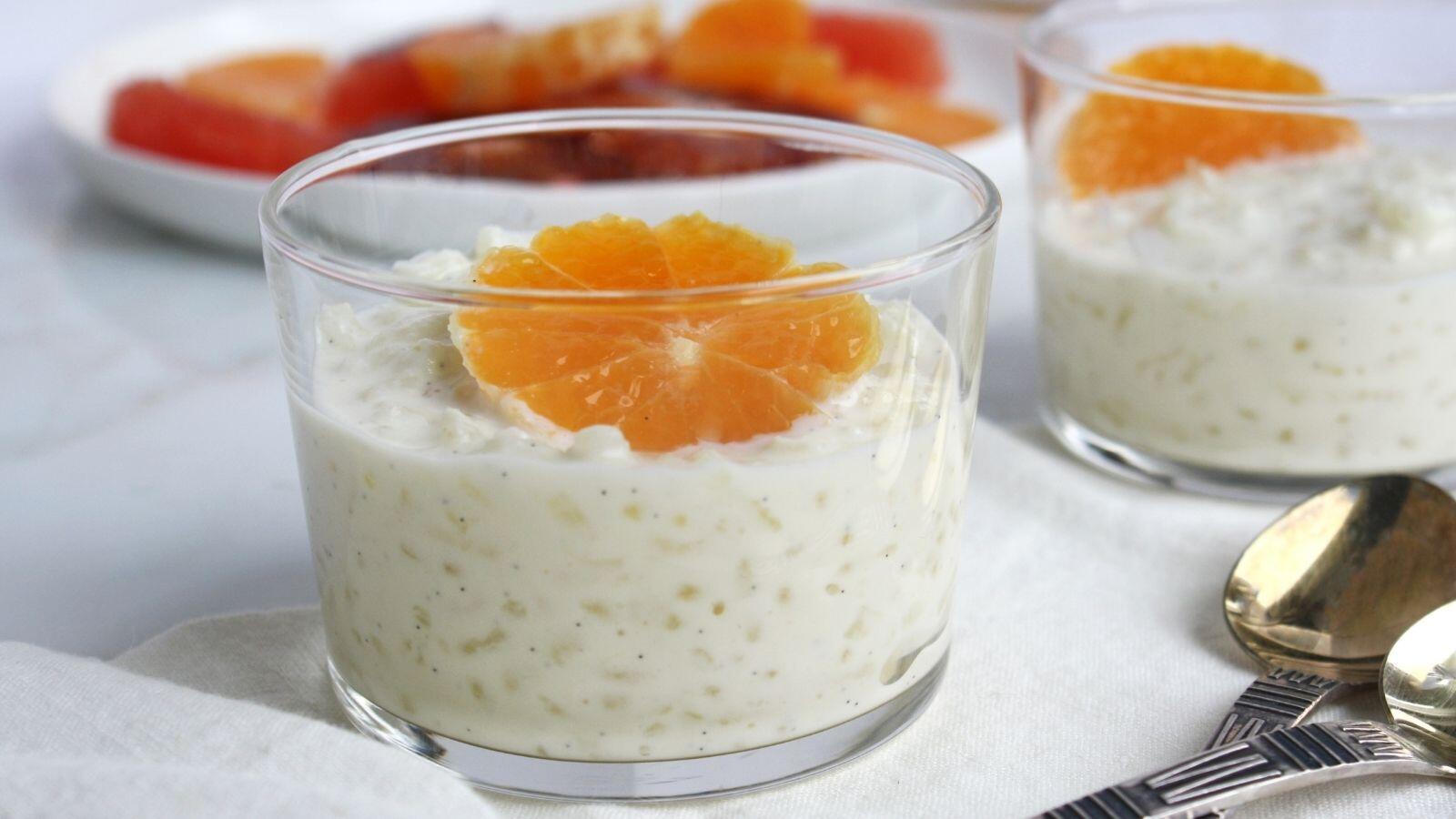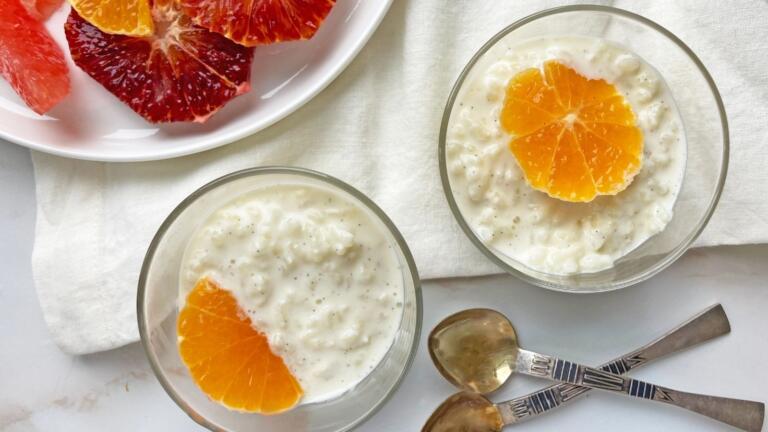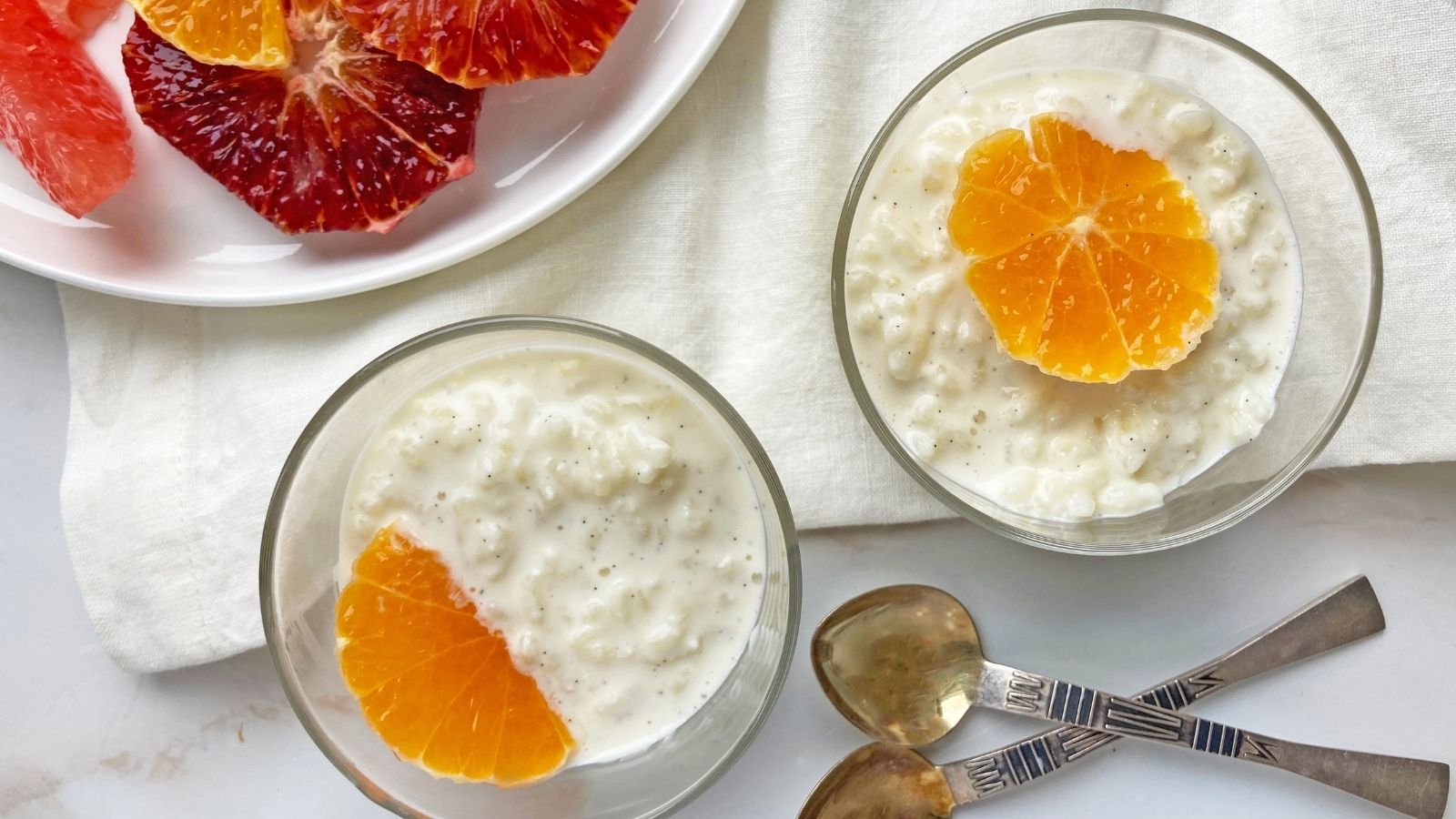Across the Jewish Diaspora, rice pudding is a staple comfort food. Food historians debate whether it originated in India or Ancient China, but we do know that rice pudding has been prepared for thousands of years. Wherever there was rice and sugar, there was rice pudding. In 15th century Europe, rice was imported from Asia along the Silk Road. It was a luxury ingredient, and rice puddings were prepared strictly for royalty. But by the 18th century, rice became more ubiquitous and less expensive, and rice pudding became a more common dish around the world.
Rice pudding may differ by country and region but typically consists of some form of rice, milk and sugar. In Indian Jewish kitchens, you’ll find kheer (or payasam), a rice pudding made with basmati rice and milk or coconut milk, that is flavored with cardamom or other spices. In many Ashkenazi kitchens, rice pudding took on the form of rice kugel and was cooked in a frying pan. In former Soviet countries, rice pudding is called molochna risova kasha and is simply prepared with rice, milk and sugar. In Turkish and Sephardic kitchens there’s sütlaҫ, a rice pudding made with rice flour that is served at weddings, after Yom Kippur, and on Shavuot and Shabbat mornings. In North Africa, Israel and throughout the Middle East, you’ll find malabi (AKA mhalbiya/muhallebi). Believed to be derived from sütlaҫ, it is a pudding made with ground rice or rice flour that is flavored with rose, orange or geranium water. Portuguese-speaking countries call their rice pudding arroz doce, and in Spanish-speaking communities, you’ll find arroz con leche flavored with cinnamon or anise. Persian Jews have sholeh zard, a golden saffron-infused rice pudding made with rice or rice flour, that is aromatically flavored with rose water, cardamom, and other spices. Here in the U.S., you’ll typically find rice pudding made with milk, sugar and studded with raisins.

This recipe for rice pudding is rich, silky and deeply vanilla flavored. I recommend using good quality Arborio or short-grain rice, as it offers a firmer and creamier texture in the pudding; but you can substitute Arborio for long-grain rice as well. Whole milk and a little half & half make this pudding decadent and silky, but you can substitute whole milk for reduced-fat milk for a lighter and slightly less creamy pudding. For a non-dairy version, substitute the milk with full-fat canned coconut milk, and the rice pudding will be just as creamy, but with added coconut flavor. Using a vanilla bean provides a special kind of decadence to this rice pudding; if you can’t get your hands on a whole bean, you can use vanilla paste or extract in its place. You can keep your pudding plain or add raisins or toppings. I like mine with citrus for a hit of acidity and brightness; and I drizzle date syrup on top just before serving, for an extra molasses-like hit of sweetness. Rice pudding can be served warm or chilled. However you like to eat or serve this pudding, it’s addictively comforting.

Jewish-American Rice Pudding with Raisins
This classic rice pudding is silky and flavorful.
- Total Time: 1 hour
- Yield: Serves 4
Ingredients
- ½ cup Arborio or short-grain sushi rice
- 3¾ cup whole milk (or substitute with low-fat milk or coconut milk)
- ¼ cup half & half or milk
- 3 Tbsp granulated sugar
- ½ a vanilla bean, 1 tsp vanilla paste or 2 tsp pure vanilla extract
- pinch of salt
- 2 Tbsp raisins or currants (optional)
- citrus segments or berries, for topping (optional)
- date syrup, for topping (optional)
Instructions
- Rinse the rice well.
- In a medium pot, combine the rice, milk, half & half, sugar and a pinch of salt.
- Split the vanilla bean, scrape out the seeds into the pot, or add the vanilla paste, and stir. If using vanilla extract, do not add it at this point. Bring the mixture up to a boil, and lower the heat to a gentle simmer. Simmer for 40-45 minutes, stirring occasionally so the mixture doesn’t stick to the bottom of the pot.
- Once the liquid has reduced and the mixture is thick and creamy, remove the pudding from the heat. Stir in the raisins and vanilla extract if using. Allow the pudding to cool for at least 10 minutes before serving or chilling.
- You can serve rice pudding warm or chilled. Top with citrus segments, fresh berries or a drizzle of date syrup, if desired.
- Prep Time: 5 minutes
- Cook Time: 50 minutes
- Category: Dessert
- Method: Stovetop
- Cuisine: Ashkenazi
The Nosher celebrates the traditions and recipes that have brought Jews together for centuries. Donate today to keep The Nosher's stories and recipes accessible to all.




This brings back memories of breakfast with brothers and sisters before school. Finding warm boiled eggs stuffed in our coat pockets to warm our hands on our walk to class. Love found us every day.
I’VE MADE THESE AND THEY TURNED OUT FANTASTIC. MY FSMILY LOVES THIS RECIPE SO I MAKE IT OFTEN.
What is the total cooking time? I can figure it out from the recipe, but you may want to correct what is noted. This sounds delicious and I definitely will try it.
This rice pudding is fabulous! The ultimate comfort food.
I had to simmer it longer than indicated in the recipe, probably due to my not-so-young stove.
I look forward to many repeats of the recipe.